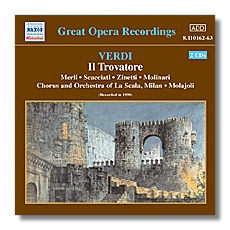
The Internet's Premier Classical Music Source
Related Links
- Verdi Reviews
- Latest Reviews
- More Reviews
-
By Composer
-
Collections
DVD & Blu-ray
Books
Concert Reviews
Articles/Interviews
Software
Audio
Search Amazon
Recommended Links
Site News
 CD Review
CD Review
Giuseppe Verdi

Il Trovatore
Arias and Scenes from I Lombardi, Ruy Blas, Guarany, and Loreley
- Bianca Scacciati (Leonora)
- Francesco Merli (Manrico)
- Giuseppina Zinetti (Azucena)
- Enrico Molinari (Conte di Luna)
- Corrado Zambelli (Ferrando
Orchestra & Chorus of La Scala, Milan/Lorenzo Molajoli
Naxos Historical 8.110162-63 ADD monaural 2CDs: 72:28, 77:41
Two Trovatores were recorded at La Scala in 1930. The first, reissued here, was recorded in May by Italian Columbia and released on 28 shellac sides. The second, recorded in October and November by HMV, was released on 30 sides. It is astonishing to think that the same opera house recorded the same work twice in the course of six months, but with a completely different cast of principals and a different conductor.
The HMV recording has been reissued by Romophone (89003-2). It features a starrier cast (tenor Aureliano Pertile, baritone Apollo Granforte, and mezzo Irene Minghini-Cattaneo) and conductor Carlo Sabajno (with extensive deputizing by Gino Nastrucci), and is generally more satisfying. However, both recordings feature a style of Verdi performance which is dead today. In 1930, Trovatore was less then 80 years old, but it already had been overrun by the "realistic" verismo style that had prevailed in Italy in the early decades of the 20th century. Also, Verdi's score was not treated as a sacred document, as would be the case later in the century. The result is a daredevil performance in which the singers throw their voices around with abandon and give vent to every interpretive quirk in their armament. Singers and composer square off, and if it is hard to tell who has won when the dust clears, no one can say that they were bored.
Probably the most memorable singer here is Molinari. He wraps his beautiful voice around "Il balen del suo sorriso" as a lesson in cantabile singing, and he avoids coarseness in a role that practically invites it. Zambelli is a solid, characterful Ferrando. While not as fine as HMV's hair-raising Minghini-Cattaneo, Zinetti is an intense Azucena with nary a hint of vocal frailty. The tenor and soprano are a little more problematic. Merli's "Ah, sì, ben mio" is gorgeous, but his tone becomes dry when he pushes his voice, and he is not dramatically imaginative; this is a Manrico who plants his feet and sings. Scacciati, a respected soprano at the time, usually sounds too matronly to be an effective Leonora. At forte and louder, her voice takes on a pinched, vinegary quality. If I were Manrico, I would have let her join that nunnery. On the other hand, she has some impressive tricks up her sleeve, including chains of imposing trills in "D'amor sull'ali rosee." The second disc contains a 35-minute appendix of Scacciati singing arias and scenes from operas that are obscure today. Here, her shortcomings are less troubling, perhaps because the competition is far sparser, and the music is a find. These five tracks redeem her largely unattractive Leonora.
Molajoli pushes the score along professionally, but moments of tenderness are few. The limitation of four-and-a-half-minute side lengths is telling.
The restoration is by Ward Marston, who used a combination of Italian, English, and American pressings to achieve the best sound with the least surface noise. Marston has used "a small amount of artificial digital reverberation" to add warmth. I have no problems with that. There are no texts, but a cued synopsis is provided.
No one should buy this as their first Trovatore, but collectors interested in old recordings of beloved works will learn much from this new reissue.
Copyright © 2002, Raymond Tuttle


















